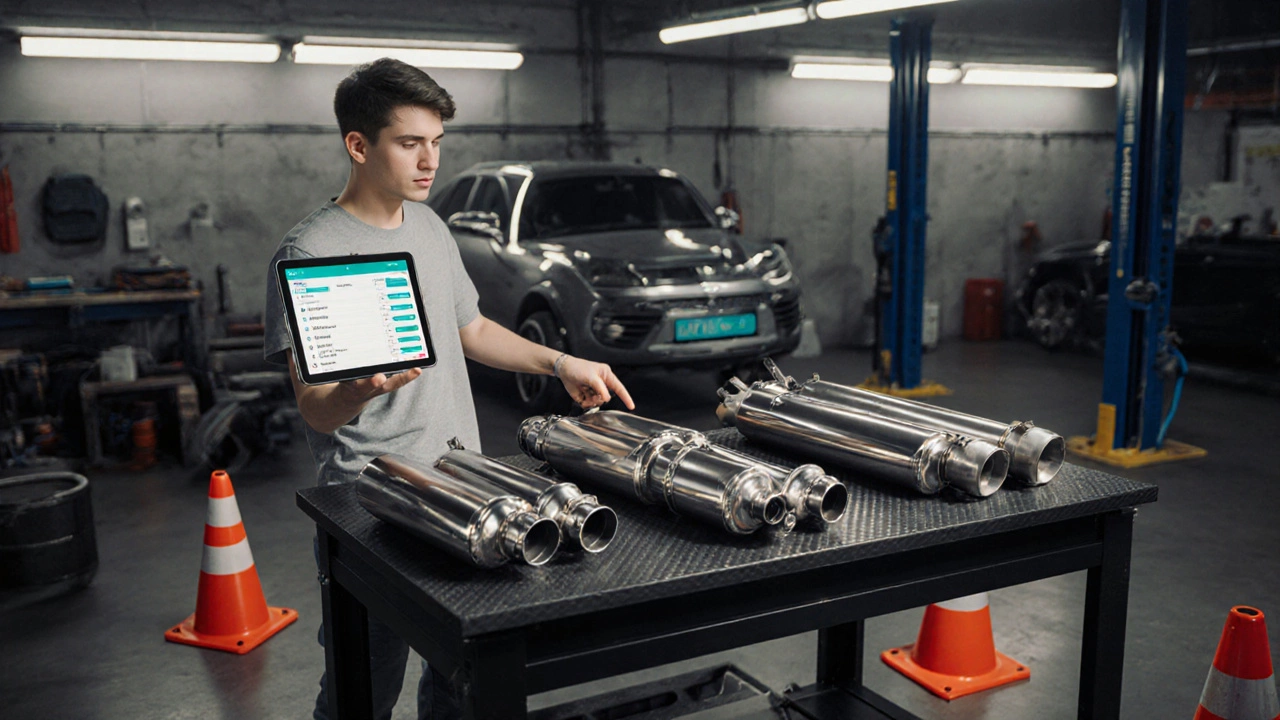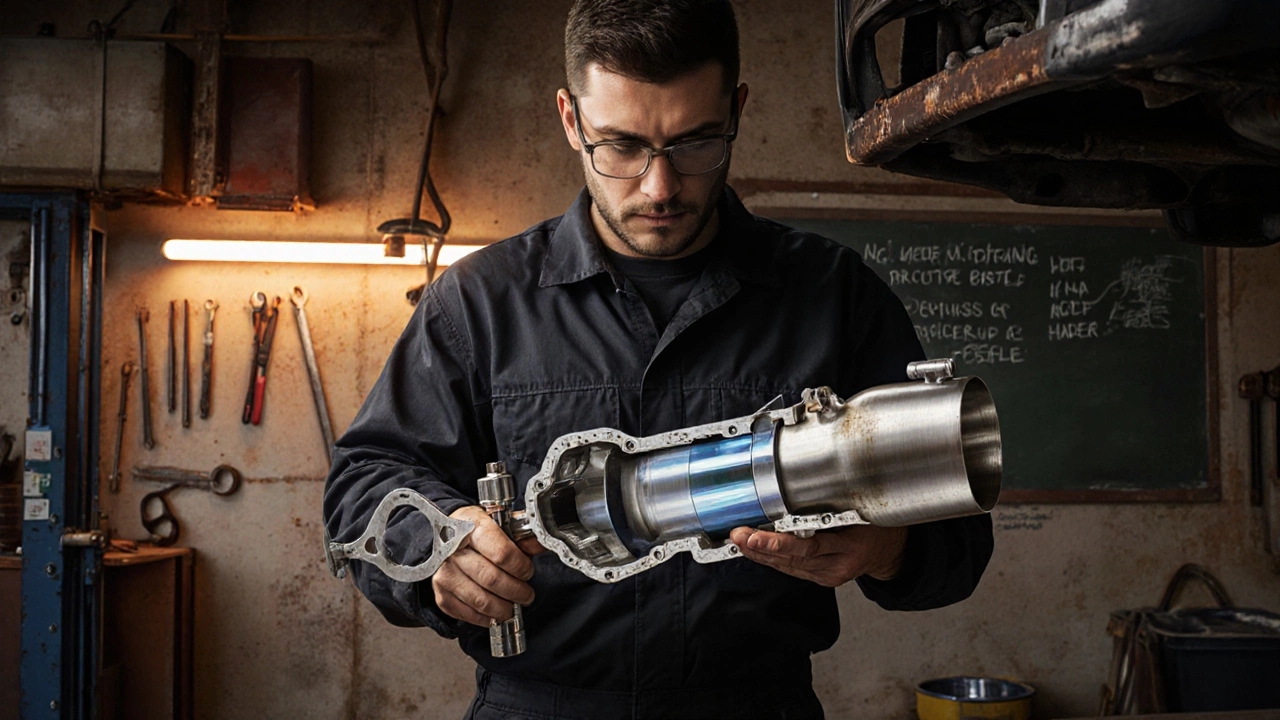 Oct, 1 2025
Oct, 1 2025
Exhaust System Selector
Recommended Exhaust System
Enter your preferences above to get personalized recommendations for your exhaust system.
Exhaust Architecture Comparison
| Type | Typical Materials | Sound Character | Power Gain (HP) | Best For |
|---|---|---|---|---|
| Cat-back | Stainless steel, Titanium | Deep, resonant | 3-7 | Street performance, sound upgrade |
| Axle-back | Stainless steel | Moderate growl | 1-3 | Budget-friendly tone change |
| Header-back | Stainless steel, Ceramic-coated | Aggressive, race-ready | 5-10 | Enthusiasts with existing mods |
| Turbo-back | Titanium, Ceramic-coated | Full-throttle roar | 8-15 | Turbocharged cars, track use |
Quick Take
- Identify your performance goal - more horsepower, deeper tone, or daily comfort.
- Match the exhaust type (cat‑back, axle‑back, header‑back, turbo‑back) to your vehicle and budget.
- Pick a material (stainless steel, titanium, ceramic‑coated) based on durability and weight.
- Check compatibility with your make/model and any emissions regulations.
- Plan for installation effort - DIY or professional help.
When you start hunting for a new exhaust system is the collection of pipes, mufflers, and resonators that guide exhaust gases out of the engine and shape the sound you hear, the sheer number of options can feel overwhelming. The right choice hinges on what you want out of the car, how much you’re willing to spend, and whether you’ll install it yourself. Below is a step‑by‑step guide that walks you through every decision point, from performance goals to material trade‑offs, so you can pick a system that actually meets your needs.
1. Define Your Performance Goal
Before you stare at a list of parts, ask yourself what you expect the upgrade to achieve. Common goals include:
- More horsepower & torque - usually a modest 3‑10% gain with freer flow.
- Deeper, throatier sound - ideal for weekend cruisers who love a rumble.
- Weight reduction - important for track enthusiasts seeking better handling.
- Better fuel efficiency - rare, but some ultra‑light systems claim a small bump.
Knowing the primary goal narrows the field dramatically because each exhaust type excels at different outcomes.
2. Pick the Exhaust Architecture That Fits Your Car
Four main architectures dominate the market:
- Cat-back exhaust is a system that replaces everything from the catalytic converter to the tailpipe
- Axle-back exhaust is a simpler swap that only replaces the muffler and tailpipe, leaving the catalytic converter untouched
- Header-back exhaust is an upgrade that starts at the exhaust manifold (or header) and runs to the catalytic converter
- Turbo-back exhaust is the most extensive kit, covering the turbocharger, downpipe, and everything to the tailpipe
Here’s how they line up:
| Type | Typical Materials | Sound Character | Power Gain (HP) | Best For |
|---|---|---|---|---|
| Cat‑back | Stainless steel, Titanium | Deep, resonant | 3‑7 | Street performance, sound upgrade |
| Axle‑back | Stainless steel | Moderate growl | 1‑3 | Budget‑friendly tone change |
| Header‑back | Stainless steel, Ceramic‑coated | Aggressive, race‑ready | 5‑10 | Enthusiasts with existing mods |
| Turbo‑back | Titanium, Ceramic‑coated | Full‑throttle roar | 8‑15 | Turbocharged cars, track use |
If you own a naturally aspirated sedan and just want a louder note, an axle‑back or cat‑back will do. For a turbocharged sports car, a turbo‑back makes the most sense because it eliminates bottlenecks before the turbine.
3. Choose the Right Material
Material choice impacts durability, weight, and corrosion resistance. The three most common options are:
- Stainless steel is the workhorse alloy (usually 304 or 409) that resists rust and costs around $2‑$4 per foot. It adds a bit of weight but lasts decades.
- Titanium is a lightweight, high‑strength metal that can shave 20‑30% off the weight of a comparable stainless system. It’s pricey ($8‑$12 per foot) but prized for track use.
- Ceramic coating is a high‑temperature finish applied to pipes that reduces heat loss and can improve flow by 1‑2%. Often bundled with stainless or titanium cores.
For daily drivers, stainless steel with a ceramic coating offers the best balance of price and longevity. If you chase lap times, titanium becomes attractive despite the cost.

4. Assess Fit, Regulations, and Emissions
Even the best‑looking exhaust is useless if it won’t bolt onto your car or if it violates local laws. Follow these steps:
- Find the exact make, model, and engine code of your vehicle. Many manufacturers publish fitment charts that match exhaust kits to VIN ranges.
- Check state or country emissions rules. Some regions require the catalytic converter to stay in place, effectively ruling out cat‑back or turbo‑back swaps that remove it.
- Read user reviews for your specific model. Fitment issues like “pipe rubs against the suspension” are often flagged early.
- If you plan to keep the car street‑legal, look for “CARB‑compliant” or “Euro5” certified kits.
Skipping this step often leads to costly returns or illegal modifications.
5. Budget and Cost Breakdown
Exhaust upgrades range from $150 for a basic axle‑back to $2,500 for a full titanium turbo‑back with custom mufflers. Here’s a typical cost breakdown:
- Exhaust kit: $150‑$2,500 depending on type and material.
- Hardware (bolts, clamps, gaskets): $20‑$100.
- Labor: $100‑$300 for professional install; DIY saves this but may need tools.
- Optional upgrades (ceramic coating, custom tips): $50‑$200.
Set a realistic ceiling, then prioritize. If you’re on a tight budget, an axle‑back in stainless steel delivers a noticeable sound improvement for under $300 total.
6. Installation Tips and Common Pitfalls
Whether you’re a seasoned gearhead or a first‑time DIYer, keep these pointers in mind:
- Lift the car safely - use a hydraulic jack and stand; never rely on a single jack. \n
- Mark original pipe locations before removal. Snap‑on magnets or chalk work well for reference.
- Torque bolts to spec. Over‑tightening can crush gaskets; under‑tightening leads to leaks.
- Check for clearance with heat shields and suspension components after the install.
- Perform a leak test by starting the engine and listening for hissing. A quick visual check for exhaust fumes around joints helps catch loose fittings.
A common mistake is ignoring the need for a new heat‑wrap on the exhaust manifold when upgrading to a header‑back system. Heat‑wrap protects surrounding components and can improve durability.
7. Real‑World Example: Upgrading a 2018 Subaru WRX
John wanted more aggressive sound and a modest 5‑HP bump without breaking his budget. He chose a stainless‑steel cat‑back exhaust because his WRX’s turbo‑back would require additional tuning. The kit cost $650, hardware $45, and a local shop installed it for $180. After the swap, his dyno test showed a 4‑HP increase, and the exhaust note added a satisfying “whoosh” at mid‑rpm. He kept the stock catalytic converter, staying legal in his state.
Follow the steps above, compare the table, and match the material to your driving style. In the end, the right exhaust system not only makes your car sound better but can also unlock a few extra horses under the hood.
Frequently Asked Questions
Will a cat‑back exhaust make my car louder?
Yes. A cat‑back replaces the stock muffler and resonator, usually resulting in a deeper and louder tone. The exact dB increase depends on the muffler design and pipe diameter.
Is it legal to remove the catalytic converter?
In most U.S. states, removing the catalytic converter is illegal for street‑driven cars because it violates emissions standards. Some states allow it for off‑road or race‑only vehicles.
Do titanium exhausts really improve performance?
Titanium’s biggest advantage is weight reduction, which can slightly improve acceleration and handling. The material itself does not dramatically increase flow, but when paired with a well‑designed pipe geometry, you can see 1‑2% power gains.
Can I install an exhaust system myself?
Most axle‑back and many cat‑back kits are DIY‑friendly with basic hand tools. Header‑back and turbo‑back kits often require specialized tools, torque specifications, and sometimes ECU tuning, so professional help is recommended for those.
How much power can I expect from an exhaust upgrade?
Typical gains range from 1‑3 HP for an axle‑back to 8‑15 HP for a full turbo‑back on a turbocharged engine. Gains are larger when the stock system is a major restriction.